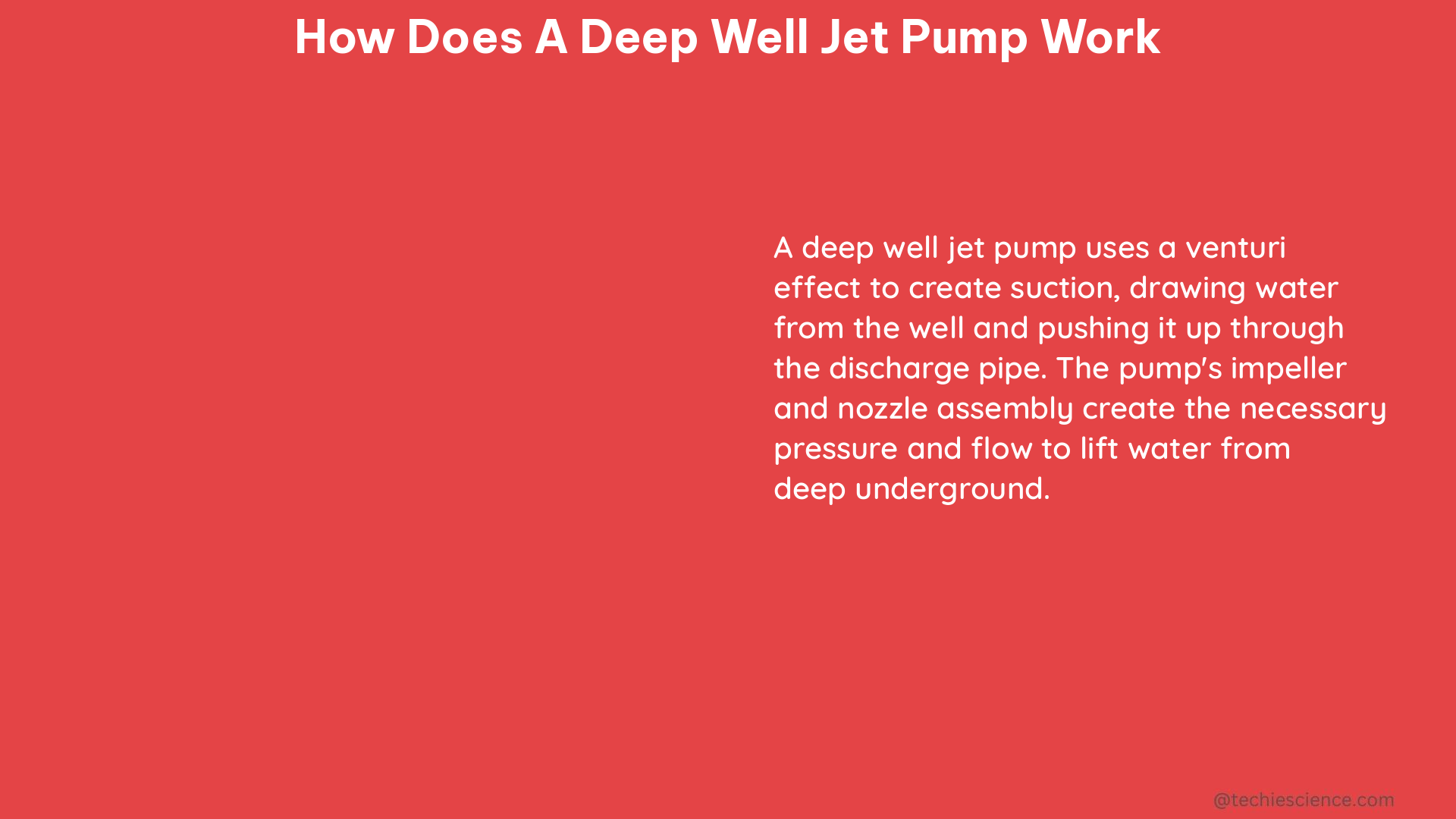A deep well jet pump is a specialized water pumping system designed to extract water from wells that are deeper than 25 feet. Unlike shallow well jet pumps, which rely on suction to draw water from wells up to 25 feet deep, deep well jet pumps utilize a unique two-pipe configuration to lift water from greater depths, making them suitable for a wide range of applications, including early well production, dewatering gas, coalbed methane, and shale wells.
Understanding the Components of a Deep Well Jet Pump System
A deep well jet pump system consists of several key components, each playing a crucial role in the overall operation:
- Pump: The pump, which is mounted above ground, is responsible for pumping water down to the ejector assembly located in the well.
- Ejector (or Jet) Assembly: The ejector assembly, installed deep within the well, is the heart of the system. It consists of a carefully matched nozzle and venturi, which work together to create suction and draw water from the well.
- Foot Valve: The foot valve, positioned at the bottom of the well, prevents water from flowing back into the well when the pump is turned off.
- Priming Plug: The priming plug is used to fill the pump with water before starting, ensuring that the impeller and diffuser are not damaged by running the pump dry.
The Principle of Operation

The deep well jet pump system works on the principle of the Venturi effect, which is the reduction in fluid pressure that occurs when a fluid flows through a constricted section of a pipe. Here’s how it works:
- The pump, located above ground, draws water from a storage tank or other water source and pumps it down the well through the smaller of the two pipes.
- As the water passes through the nozzle in the ejector assembly, its velocity increases, and its pressure drops, creating a suction around the nozzle.
- This suction draws water from the well into the ejector assembly, where it mixes with the recirculated water from the pump.
- The combined water flow is then pushed back up the larger of the two pipes, delivering the water to the surface.
Advantages of Deep Well Jet Pumps
Deep well jet pumps offer several advantages over other water pumping systems:
- Depth Capability: Deep well jet pumps can lift water from depths of over 160 feet, making them suitable for a wide range of well depths.
- High Water Volume: Deep well jet pumps are capable of handling high volumes of water, making them ideal for early well production and dewatering applications.
- Versatility: Jet pumps can be configured to run multiple wells, reducing lease operating expenses by limiting the amount of equipment on location.
- Reliability: Deep well jet pumps are known for their durability and reliability, with fewer moving parts compared to other pump types, reducing maintenance requirements.
Technical Specifications and Performance Characteristics
Deep well jet pumps are available in a range of sizes and configurations to meet the specific needs of different applications. Some key technical specifications and performance characteristics include:
- Depth Capability: Up to 200 feet
- Flow Rates: Typically ranging from 10 to 100 gallons per minute (GPM)
- Power Requirements: Typically ranging from 0.5 to 5 horsepower (HP)
- Efficiency: Typically ranging from 30% to 50%, depending on the specific pump design and operating conditions
- Suction Lift: Up to 25 feet for the shallow well ejector, and up to 160 feet for the deep well ejector
Maintenance and Troubleshooting
Proper maintenance and troubleshooting are essential for ensuring the long-term reliability and performance of a deep well jet pump system. Some key maintenance tasks include:
- Regularly inspecting and cleaning the ejector assembly to prevent clogging or wear
- Checking the pump’s priming and ensuring that the system is properly filled with water before starting
- Monitoring the pump’s performance and addressing any issues, such as decreased flow rate or pressure, promptly
- Replacing worn or damaged components, such as the nozzle, venturi, or impeller, as needed
By understanding the inner workings of a deep well jet pump and following best practices for maintenance and troubleshooting, you can ensure that your system continues to operate efficiently and reliably for years to come.
Reference:
- Jet Pumps — Part 1 – The Driller
- The Defining Series: Jet Pumps – SLB
- What components are used in a shallow and deep well jet pump system – Boshart
- The Basics of a Jet Pump – YouTube

The lambdageeks.com Core SME Team is a group of experienced subject matter experts from diverse scientific and technical fields including Physics, Chemistry, Technology,Electronics & Electrical Engineering, Automotive, Mechanical Engineering. Our team collaborates to create high-quality, well-researched articles on a wide range of science and technology topics for the lambdageeks.com website.
All Our Senior SME are having more than 7 Years of experience in the respective fields . They are either Working Industry Professionals or assocaited With different Universities. Refer Our Authors Page to get to know About our Core SMEs.